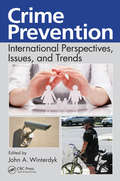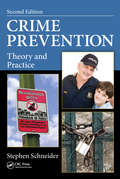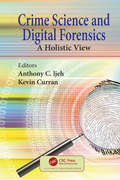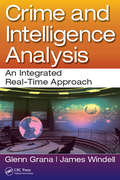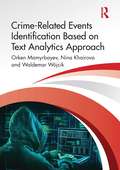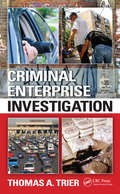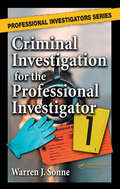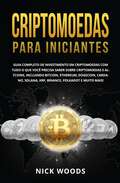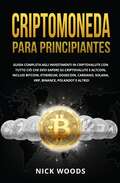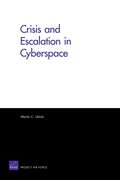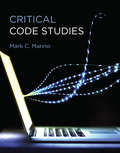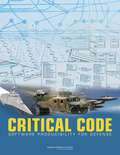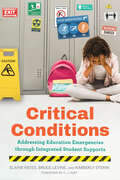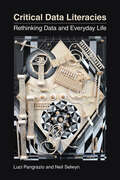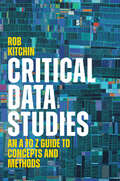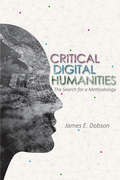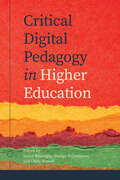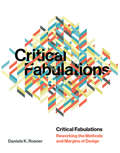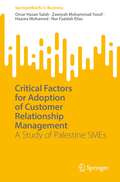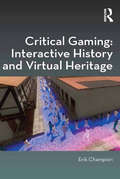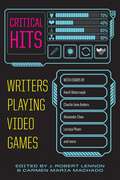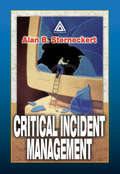- Table View
- List View
Crime Prevention: International Perspectives, Issues, and Trends
by John A. WinterdykThis text presents an international approach to the study of crime prevention. It offers an expansive overview of crime prevention initiatives and how they are applied across a wide range of themes and infractions, from conventional to non-conventional forms of crime. Based on a review of the literature, this is the first text to offer a broad, yet comprehensive, examination of how and why crime prevention has gained considerable traction as an alternative to conventional criminal justice practices of crime control in developed countries, and to provide a cross-sectional view of how crime prevention has been applied and how effective such initiatives have been. Crime Prevention: International Perspectives, Issues, and Trends is suitable for undergraduate students in criminology and criminal justice programs, as well as for graduates and undergraduates in special topics courses.
Crime Prevention: Theory and Practice, Second Edition
by Stephen SchneiderIn Crime Prevention: Theory and Practice, Second Edition, Dr. Schneider has updated every chapter in this reliable text using the latest research, the most recently published articles and books, and feedback from professors and students using the first edition. Providing an introduction to dominant approaches, key concepts, theories, and research,
Crime Science and Digital Forensics: A Holistic View
by Anthony C. IjehThis volume is a collation of articles on counter forensics practices and digital investigative methods from the perspective of crime science. The book also shares alternative dialogue on information security techniques used to protect data from unauthorised access and manipulation. Scandals such as those at OPCW and Gatwick Airport have reinforced the importance of crime science and the need to take proactive measures rather than a wait and see approach currently used by many organisations. This book proposes a new approach in dealing with cybercrime and unsociable behavior involving remote technologies using a combination of evidence-based disciplines in order to enhance cybersecurity and authorised controls. It starts by providing a rationale for combining selected disciplines to enhance cybersecurity by discussing relevant theories and highlighting the features that strengthen privacy when mixed. The essence of a holistic model is brought about by the challenge facing digital forensic professionals within environments where tested investigative practices are unable to provide satisfactory evidence and security. This book will be of interest to students, digital forensic and cyber security practitioners and policy makers. It marks a new route in the study of combined disciplines to tackle cybercrime using digital investigations and crime science.
Crime and Intelligence Analysis: An Integrated Real-Time Approach
by James Windell Glenn GranaCrime and Intelligence Analysis: An Integrated Real-Time Approach covers everything crime analysts and tactical analysts need to know to be successful. Providing an overview of the criminal justice system as well as the more fundamental areas of crime analysis, the book will enable students and law enforcement personnel to better understand criminal behavior, learn the basics of conducting temporal analysis of crime patterns, use spatial analysis to better understand crime, apply research methods to crime analysis, and more successfully evaluate data and information to help predict criminal offending and solve criminal cases. Criminal justice and police academy students will learn how to be skilled and credible crime analysts who play a critical role in the daily operations of law enforcement.
Crime-Related Events Identification Based on Text Analytics Approach
by Waldemar Wójcik Orken Mamyrbayev Nina KhairovaAs modern society is extremely dependent on the Internet, social networks, and developing technologies, a threat to the security of both the individual and society as a whole has emerged. The openness and global nature of the Internet create opportunities both for criminals, who can use the available information for criminal purposes, and for law enforcement officials. Police officers, in turn, can deal with the preventive processing of data from the Internet in order to prevent crimes. This type of data analysis can detect illegal or criminal actions even at the stage of their formation. Crime-Related Events Identification Based on Text Analytics Approach describes the possibilities of extracting crime-related facts from semi-structured information from various Internet sources so that crime can be combatted. This book is aimed at police officers and IT professionals working in online investigations.
Crimes and Cover-ups in American Politics: 1776-1963
by Donald JeffriesThe history that the textbooks left out. For far too long, American history has been left in the unreliable hands of those that author Donald Jeffries refers to as the court historians. Crimes and Cover-ups in American Politics: 1776-1963 fights back by scrutinizing the accepted history of everything from the American War of Independence to the establishment reputation of Thomas Jefferson and the other Founding Fathers, the Civil War, the Lincoln assassination, both World Wars, US government experimentation on prisoners, mental patients, innocent children and whole populated areas, the Lindbergh baby kidnapping and much, much more. Secular saints like Abraham Lincoln, Theodore Roosevelt, and Franklin D. Roosevelt are examined in a critical way they seldom have been. Jeffries spares no one and nothing in this explosive new book. The atrocities of Union troops during the Civil War, and Allied troops during World War II, are documented in great detail. The Nuremberg Trials are presented as the antithesis of justice. In the follow-up to his previous, bestselling book Hidden History: An Expose of Modern Crimes, Conspiracies, and Cover-Ups in American Politics, Jeffries demonstrates that crimes, corruption, and conspiracies didn't start with the assassination of President John F. Kennedy. History should be much more than cardboard villains and impossibly unrealistic heroes. Thanks to the efforts of the court historians, most Americans are historically illiterate. Crimes and Cover-ups in American Politics: 1776-1963 is a bold attempt at setting the record straight.
Criminal Enterprise Investigation
by Thomas A. TrierMany cities, towns, and municipalities across the United States have criminal organizations operating within their jurisdictions. This book gives the investigator a guide to probing, evaluating, and analyzing local criminal organizations, with the goal of disrupting and dismantling criminal operations. Subjects covered include investigative field techniques, identification of enterprise vulnerabilities, and an in-depth look into FBI task forces. Intended for law enforcement and other criminal justice professionals, Criminal Enterprise Investigation provides readers with a critical "how to" guide to overcoming criminal enterprise in their communities. Features: Provides step-by-step guide to dismantling criminal organizations Includes real-life examples of successful investigations Covers a wide range of criminal groups, including domestic terrorists, drug cartels, gangs, white-collar criminals, and robbery and extortion rings For those working to combat criminal organizations, this book is an essential guide to best practices. Criminal Enterprise Investigation provides the theory, techniques, and real-world examples necessary to overcome criminal activity for those of any level of expertise, from seasoned criminal justice professionals to those just beginning their careers.
Criminal Investigation for the Professional Investigator (Professional Investigators Series)
by BCPI, CLI, SonneAimed at the busy professional who aspires to become certified in the field, Criminal Investigation for the Professional Investigator details essential techniques a trained investigator will be called upon to perform during the course of a career. The book is authored by a veteran of the NYPD who went on to launch and operate two successful private investigation agencies. It covers crime scenes, death investigations, the art of interrogation, and specific criminal investigations. It also provides important strategies for making arrests and testifying in courtrooms, details the most effective investigative tools to use, and explains the role of criminal defense investigators.
Criptomoedas para Iniciantes: Guia Completo De Investimento Em Criptomoedas Com Tudo O Que Você Precisa Saber Sobre Criptomoedas
by Nick WoodsGuia Completo de Investimento em Criptomoedas com Tudo o que Precisa de Saber sobre Ciptomoedas e Altcoin. Tudo o que Precisa de Saber sobre Altcoins, incluindo Bitcoin, Ethereum, Dogecoin, Cardano, Solana, XRP, Binance, Polkadot e muito mais! Neste livro, abordaremos vários tópicos que permitirão que você construa um conhecimento perspicaz sobre o mundo das criptomoedas. Criptomoeda não é um termo singular, abrange várias moedas digitais que podem ser usadas para comprar bens e serviços ou trocadas. Quase um terço dos investidores em criptomoedas têm entre 25 a 34 anos, tornando-se um investimento popular entre os mais jovens. No entanto, qualquer pessoa de qualquer idade ou formação pode garantir um bom retorno ao investir nestas moedas. As criptomoedas não existem no sentido físico e são totalmente digitizadas. Isto significa que os registos das moedas são mantidos e registados em bancos de dados virtuais altamente seguros. Consequentemente, estes são menos propensos a falsificação criminal. Com um aumento constante e contínuo na popularidade das criptomoedas, negociá-las é uma ótima forma de obter um bom retorno de qualquer investimento financeiro. Contudo, terá de garantir que faz da maneira correta. Abordaremos o que significa criptomoeda e os vários tipos de criptomoedas. Além dos conhecimentos sobre criptomoedas, também irá aprender sobre a tecnologia blockchain e como esta funciona. Acima de tudo, uma informação importante a ser lembrada é que é bom começar pequeno em vez de se lançar no mercado. Aumento os seus investimentos gradualmente à medida que aprende a negociar nos mercados. Com tempo e prática, tornar-se-á num investidor experiente e confiante em criptomoedas. O investimento em criptomoedas é um trabalho paralelo para muitas pessoas, mas pode tornar-se no foco principal das suas estratégias financeiras. Com o mercado de criptomoedas a atingirem máximas gerais de do
Criptomoneda para Principiantes: Guía Completa de Inversión en Criptomonedas.
by Nick Woods¿Está buscando aprender cómo puede sacar provecho de la revolución de las criptomonedas? ¿Has escuchado sobre Bitcoin, Ethereum y Dogecoin últimamente en las noticias y parece que no puedes entender qué son las criptomonedas? ¿Se pregunta cómo puede comenzar a invertir en criptomonedas, pero realmente no sabe qué es y tiene dudas sobre invertir en algo que no comprende? ¿Desearía poder comprender la criptomoneda, pero tiene miedo de que sea demasiado compleja y complicada? Si esto te suena, ¡sigue leyendo! Las criptomonedas son fascinantes monedas descentralizadas de la nueva era que solo están disponibles en línea y permiten al usuario ser algo anónimo. Con miles de criptomonedas disponibles, existen importantes potenciales de crecimiento. ¡La gran cantidad de proyectos construidos sobre estas cadenas de bloques es prueba suficiente de que la criptomoneda se dirige a la luna!
Crisis Communication in a Digital World
by Mark Sheehan Deirdre Quinn-AllanCrisis communication in a digital world provides an introduction to major crisis communication theories and issues management, using practical examples from Australia and New Zealand. The book examines how public relations can influence the nature of a crisis and the impact of its aftermath. It explores the role of PR specialists in different crisis situations - including natural disasters and morphing crises - and examines the challenges they face in a world where social media is a key source of communication. Readers are provided with an in-depth understanding of crisis communication and issues management through practical approaches, strategies and skills, which are supplemented by relevant theories based on evidence and experience. International perspectives have been included throughout to illustrate the impact of multinational companies on the digital world, including global media cycles and social media activism. Each chapter explores a different aspect of communications, including media, natural disasters and celebrity crises.
Crisis and Escalation in Cyberspace
by Martin C. LibickiThe chances are growing that the United States will find itself in a crisis in cyberspace-the escalation of tensions associated with a major cyberattack, suspicions that one has taken place, or fears that it might do so soon. Such crises can be managed by taking steps to reduce the incentives for other states to step in, controlling the narrative, understanding the stability parameters of the crises, and recognizing escalation risks.
Crisis on the Coast and Hinterland: Assessing India’s East Coast with Geomorphological, Environmental and Remote Sensing and GIS Approaches
by Ashis Kumar Paul Anurupa PaulThis contributed volume assesses the state and future of India’s East Coast through a wide variety of chapters grouped by methodology and approach. Part I: Assessment through Geomorphological Approaches describes geomorphological diversities of the eastern shorelines of India, Coastal Modelling System- SMC and morphodynamics of Odisha coast, Paleo shorelines and beach ridge chenier formations of Subarnarekha delta, seasonal sediment budget of Chandrabhaga beachdune system, Beach stage and dune stage modelling Mandarmoni coast, drainage characters of South Andaman Islands, coastal foredune morphology and sediment of Odisha and West Bengal, Geo-archaeological pieces of evidence of ancient coastal environment, coastal sediment characters, beach ridge formation in the chenier coast, and geomorphological changes of ancient ports and harbours in the shoreline of West Bengal. Part II: Assessment through Environmental Approaches addresses various environmental assessment techniques of mangrove sensitivity to the sea level rise process in the Sundarban, land degradation of the hinterland drainage basins, the riparian environment of the coastal drainage basins, agricultural adaptability in response to climate variability in the coastal areas of West Bengal, forest degradations of the lateritic upland tracts, coastal tourism potentialities in Odisha and West Bengal, Climate variabilities and agricultural modifications in the hinterland areas of West Bengal districts, the tidal flat environment of Sagar Island, landforms and Geomorphosites for the promotion of Geotourism in South Andaman Perils of Premature Reclamation of Sundarban, marine litter in the coastal regions of West Bengal and Odisha on flora, fauna and humans, Ground water contamination due to saline water encroachment in coastal Andhra Pradesh and Spatio-temporal changes in the Hugli estuarine environment and coastal hazards and flood risk of southwestern Sundarban. Part III: Assessment through Remote Sensing & GIS Approaches uses the aforementioned techniques in service of exploration of monitoring health of Mangrove forest, Geomorphological analysis of the coral fringed coasts of Andaman, hydrological and morphological variations of Ichhamati Tidal estuary, multivariate analysis of coastal vulnerabilities, geography of tourism resources in Andaman group of islands, tourism climate index with application geospatial techniques, diversity of landscape ecology in the coastal blocks of Purba Medinipur, overwash vulnerability in Odisha coast, livelihood security index of the coastal communities, managing coastal squeeze response and wetland loss in the estuarine coastal tract of West Bengal, environmental effects of historical land reclamation process in the Sundarban, and emerging environmental problems of coastal urbanization in Digha, Kanthi, and Haldia.
Critical Code Studies: Initial Methods (Software Studies)
by Mark C. MarinoAn argument that we must read code for more than what it does—we must consider what it means.Computer source code has become part of popular discourse. Code is read not only by programmers but by lawyers, artists, pundits, reporters, political activists, and literary scholars; it is used in political debate, works of art, popular entertainment, and historical accounts. In this book, Mark Marino argues that code means more than merely what it does; we must also consider what it means. We need to learn to read code critically. Marino presents a series of case studies—ranging from the Climategate scandal to a hactivist art project on the US-Mexico border—as lessons in critical code reading.Marino shows how, in the process of its circulation, the meaning of code changes beyond its functional role to include connotations and implications, opening it up to interpretation and inference—and misinterpretation and reappropriation. The Climategate controversy, for example, stemmed from a misreading of a bit of placeholder code as a “smoking gun” that supposedly proved fabrication of climate data. A poetry generator created by Nick Montfort was remixed and reimagined by other poets, and subject to literary interpretation.Each case study begins by presenting a small and self-contained passage of code—by coders as disparate as programming pioneer Grace Hopper and philosopher Friedrich Kittler—and an accessible explanation of its context and functioning. Marino then explores its extra-functional significance, demonstrating a variety of interpretive approaches.
Critical Code: Software Producibility for Defense
by National Research Council of the National AcademiesCritical Code contemplates Department of Defense (DoD) needs and priorities for software research and suggests a research agenda and related actions. Building on two prior books--Summary of a Workshop on Software Intensive Systems and Uncertainty at Scale and Preliminary Observations on DoD Software Research Needs and Priorities--the present volume assesses the nature of the national investment in software research and, in particular, considers ways to revitalize the knowledge base needed to design, produce, and employ software-intensive systems for tomorrow's defense needs. Critical Code discusses four sets of questions: To what extent is software capability significant for the DoD? Is it becoming more or less significant and strategic in systems development? Will the advances in software producibility needed by the DoD emerge unaided from industry at a pace sufficient to meet evolving defense requirements? What are the opportunities for the DoD to make more effective use of emerging technology to improve software capability and software producibility? In which technology areas should the DoD invest in research to advance defense software capability and producibility?
Critical Conditions: Addressing Education Emergencies Through Integrated Student Supports
by Elaine Weiss Bruce Levine Kimberly SterinA proactive, ground-level approach to student support that helps ameliorate the effects of socioeconomic challenges and improves outcomes for students, families, and communities
Critical Data Literacies: Rethinking Data and Everyday Life
by Neil Selwyn Luci PangrazioA guide to everything you need to understand to navigate a world increasingly governed by data.Data has become a defining issue of current times. Our everyday lives are shaped by the data that is produced about us (and by us) through digital technologies. In this book, Critical Data Literacies, Luci Pangrazio and Neil Selwyn introduce readers to the central concepts, ideas, and arguments required to make sense of life in the data age. The authors challenge the idea that datafication is an inevitable and inescapable condition. Drawing on emerging areas of scholarship such as data justice, data feminism, and other critical data studies approaches, they explore how individuals and communities can empower themselves to engage with data critically and creatively.Over the course of eight wide-ranging chapters, the book introduces readers to the main components of critical data literacies—from the fundamentals of identifying and understanding data to the complexities of engaging with more combative data tactics. Critical Data Literacies explores how the tradition of critical literacies can offer a powerful foundation to address the big concerns of the data age, such as issues of data justice and privacy, algorithmic bias, dataveillance, and disinformation. Bringing together cutting-edge thinking and discussion from across education, sociology, psychology, and media and communication studies, Critical Data Literacies develops a powerful argument for collectively rethinking the role that data plays in our everyday lives and re-establishing agency, free will, and the democratic public sphere.
Critical Data Studies: An A to Z Guide to Concepts and Methods
by Rob KitchinCritical Data Studies has come of age as a vibrant, interdisciplinary field of study. Taking data as its primary analytical focus, the field theorises the nature of data; examines how data are produced, managed, governed and shared; investigates how they are used to make sense of the world and to perform practical action; and explores whose agenda data-driven systems serve.This book is the first comprehensive A-Z guide to the concepts and methods of Critical Data Studies, providing succinct definitions and descriptions of over 400 key terms, along with suggested further reading. The book enables readers to quickly navigate and improve their comprehension of the field, while also acting as a guide for discovering ideas and methods that will be of value in their own studies. Critical Data Studies is essential reading for students and scholars from across the sciences, social sciences and humanities, as well as those who work with data professionally who want to extend and enrich their conceptual and practical understanding of data and their use.This will be available as an Open Access book.
Critical Digital Humanities: The Search for a Methodology (Topics in the Digital Humanities)
by James E DobsonCan established humanities methods coexist with computational thinking? It is one of the major questions in humanities research today, as scholars increasingly adopt sophisticated data science for their work. <P><P>James E. Dobson explores the opportunities and complications faced by humanists in this new era. Though the study and interpretation of texts alongside sophisticated computational tools can serve scholarship, these methods cannot replace existing frameworks. <P><P>As Dobson shows, ideas of scientific validity cannot easily nor should be adapted for humanities research because digital humanities, unlike science, lack a leading-edge horizon charting the frontiers of inquiry. <P><P>Instead, the methods of digital humanities require a constant rereading. At the same time, suspicious and critical readings of digital methodologies make it unwise for scholars to defer to computational methods. <P><P>Humanists must examine the tools--including the assumptions that went into the codes and algorithms--and questions surrounding their own use of digital technology in research. <P><P>Insightful and forward thinking, Critical Digital Humanities lays out a new path of humanistic inquiry that merges critical theory and computational science.
Critical Digital Pedagogy in Higher Education (Issues in Distance Education)
by George Veletsianos Chris Rowell Suzan KöseoğluRecent efforts to solve the problems of education—created by neoliberalism in and out of higher education—have centred on the use of technology that promises efficiency, progress tracking, and automation. The editors of this volume argue that using technology in this way reduces learning to a transaction. They ask administrators, instructors, and learning designers to reflect on our relationship with these tools and explore how to cultivate a pedagogy of care in an online environment. With an eye towards identifying different and better possibilities, this collection investigates previously under-examined concepts in the field of digital pedagogy such as shared learning and trust, critical consciousness, change, and hope.
Critical Fabulations: Reworking the Methods and Margins of Design (Design Thinking, Design Theory)
by Daniela K RosnerA proposal to redefine design in a way that not only challenges the field's dominant paradigms but also changes the practice of design itself.In Critical Fabulations, Daniela Rosner proposes redefining design as investigative and activist, personal and culturally situated, responsive and responsible. Challenging the field's dominant paradigms and reinterpreting its history, Rosner wants to change the way we historicize the practice, reworking it from the inside. Focusing on the development of computational systems, she takes on powerful narratives of innovation and technology shaped by the professional expertise that has become integral to the field's mounting status within the new industrial economy. To do so, she intervenes in legacies of design, expanding what is considered “design” to include long-silenced narratives of practice, and enhancing existing design methodologies based on these rediscovered inheritances. Drawing on discourses of feminist technoscience, she examines craftwork's contributions to computing innovation—how craftwork becomes hardware manufacturing, and how hardware manufacturing becomes craftwork. She reclaims, for example, NASA's “Little Old Ladies,” the women who built information storage for the Apollo missions by weaving wires through magnetized metal rings.Mixing history, theory, personal experience, and case studies, Rosner reweaves fibers of technoscience by slowly reworking the methods and margins of design. She suggests critical fabulations as ways of telling stories that awaken alternative histories, and offers a set of techniques and orientations for fabulating its future. Critical Fabulations shows how design's hidden inheritances open different possibilities for practice.
Critical Factors for Adoption of Customer Relationship Management: A Study of Palestine SMEs (SpringerBriefs in Business)
by Nur Fazidah Elias Hazura Mohamed Omar Hasan Salah Zawiyah Mohammad YusofThis book explores the challenges in adopting customer relationship management (CRM) models in developing countries, with a focus on Palestine. Examining the cultural, organizational, and technological contexts, it reveals how these factors create adoption gaps, impacting customer pressure, employee engagement, and security. The narrative, enriched by real-world examples from Palestine, underscores the unique hurdles faced by firms in such environments. Emphasizing the central role of customers in business, the book delves into the initiatives many firms take to enhance customer services, target profitable segments, and improve acquisition and retention. However, in developing nations, these efforts encounter distinctive challenges. The book offers a practical CRM model tailored to the specific needs of small and medium-sized enterprises (SMEs), illustrating how technology can elevate competitiveness. With a strategic perspective, it positions CRM as a catalyst for SMEs to navigate the complexities of the dynamic economy, providing actionable insights for professionals, scholars, and business management students. This comprehensive guide encapsulates the nuances of CRM adoption, making it an invaluable resource for those seeking sustainable growth in developing country contexts.
Critical Gaming: Interactive History and Virtual Heritage (Digital Research in the Arts and Humanities)
by Erik ChampionThis book explains how designing, playing and modifying computer games, and understanding the theory behind them, can strengthen the area of digital humanities. This book aims to help digital humanities scholars understand both the issues and also advantages of game design, as well as encouraging them to extend the field of computer game studies, particularly in their teaching and research in the field of virtual heritage. By looking at re-occurring issues in the design, playtesting and interface of serious games and game-based learning for cultural heritage and interactive history, this book highlights the importance of visualisation and self-learning in game studies and how this can intersect with digital humanities. It also asks whether such theoretical concepts can be applied to practical learning situations. It will be of particular interest to those who wish to investigate how games and virtual environments can be used in teaching and research to critique issues and topics in the humanities, particularly in virtual heritage and interactive history.
Critical Hits: Writers Playing Video Games
by J. Robert Lennon Carmen Maria MachadoFrom the earliest computers to the smartphones in our pockets, video games have been on our screens and part of our lives for over fifty years. Critical Hits celebrates this sophisticated medium and considers its lasting impact on our culture and ourselves. This collection of stylish, passionate, and searching essays opens with an introduction by Carmen Maria Machado, who edited the anthology alongside J. Robert Lennon. In these pages, writer-gamers find solace from illness and grief, test ideas about language, bodies, power, race, and technology, and see their experiences and identities reflected in―or complicated by―the interactive virtual worlds they inhabit. Elissa Washuta immerses herself in The Last of Us during the first summer of the pandemic. Nana Kwame Adjei-Brenyah describes his last goodbye to his father with the help of Disco Elysium. Jamil Jan Kochai remembers being an Afghan American teenager killing Afghan insurgents in Call of Duty. Also included are a comic by MariNaomi about her time as a video game producer; a deep dive into “portal fantasy” movies about video games by Charlie Jane Anders; and new work by Alexander Chee, Hanif Abdurraqib, Larissa Pham, and many more.
Critical Incident Management
by Alan B. SterneckertMost businesses are aware of the danger posed by malicious network intruders and other internal and external security threats. Unfortunately, in many cases the actions they have taken to secure people, information and infrastructure from outside attacks are inefficient or incomplete. Responding to security threats and incidents requires a competent
